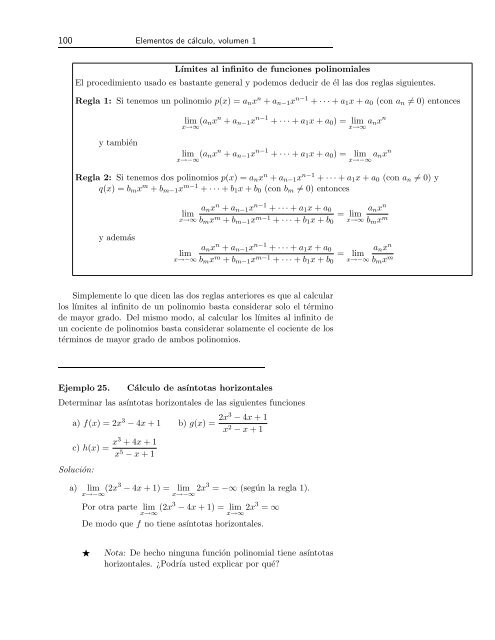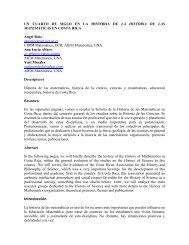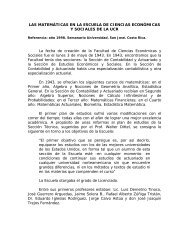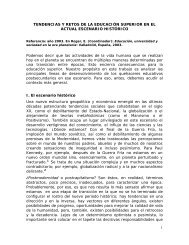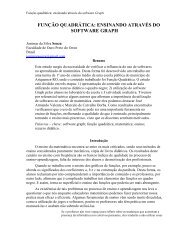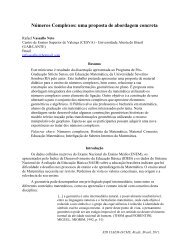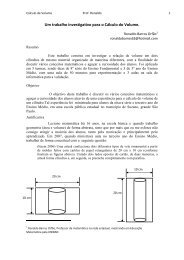Create successful ePaper yourself
Turn your PDF publications into a flip-book with our unique Google optimized e-Paper software.
100 Elementos de cálculo, volumen 1<br />
Límites al infinito de funciones polinomiales<br />
El procedimiento usado es bastante general y podemos deducir de él las dos reglas siguientes.<br />
Regla 1: Si tenemos un polinomio p(x) = anx n + an−1x n−1 + · · · + a1x + a0 (con an = 0) entonces<br />
y también<br />
lim<br />
x→∞ (anx n + an−1x n−1 n<br />
+ · · · + a1x + a0) = lim anx<br />
x→∞<br />
lim<br />
x→−∞ (anx n + an−1x n−1 n<br />
+ · · · + a1x + a0) = lim anx<br />
x→−∞<br />
Regla 2: Si tenemos dos polinomios p(x) = anx n + an−1x n−1 + · · · + a1x + a0 (con an = 0) y<br />
q(x) = bmx m + bm−1x m−1 + · · · + b1x + b0 (con bm = 0) entonces<br />
y además<br />
lim<br />
x→∞<br />
lim<br />
x→−∞<br />
anx n + an−1x n−1 + · · · + a1x + a0<br />
bmx m + bm−1x m−1 + · · · + b1x + b0<br />
anx n + an−1x n−1 + · · · + a1x + a0<br />
bmx m + bm−1x m−1 + · · · + b1x + b0<br />
Simplemente lo que dicen las dos reglas anteriores es que al calcular<br />
los límites al infinito de un polinomio basta considerar solo el término<br />
de mayor grado. Del mismo modo, al calcular los límites al infinito de<br />
un cociente de polinomios basta considerar solamente el cociente de los<br />
términos de mayor grado de ambos polinomios.<br />
Ejemplo 25. Cálculo de asíntotas horizontales<br />
Determinar las asíntotas horizontales de las siguientes funciones<br />
a) f(x) = 2x 3 − 4x + 1 b) g(x) = 2x3 − 4x + 1<br />
x 2 − x + 1<br />
c) h(x) = x3 + 4x + 1<br />
x 5 − x + 1<br />
Solución:<br />
a) lim<br />
x→−∞ (2x3 − 4x + 1) = lim<br />
x→−∞ 2x3 = −∞ (según la regla 1).<br />
Por otra parte lim<br />
x→∞ (2x3 − 4x + 1) = lim<br />
x→∞ 2x3 = ∞<br />
De modo que f no tiene asíntotas horizontales.<br />
⋆ Nota: De hecho ninguna función polinomial tiene asíntotas<br />
horizontales. ¿Podría usted explicar por qué?<br />
anx<br />
= lim<br />
x→∞<br />
n<br />
bmxm anx<br />
= lim<br />
x→−∞<br />
n<br />
bmxm


